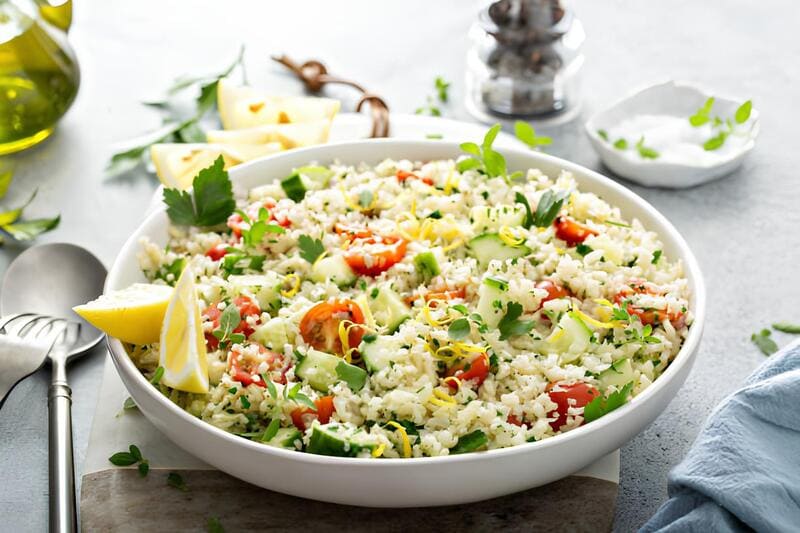
Cauliflower Tabbouleh is a delightful, low-carb variation of the classic Middle Eastern salad, traditionally known as Lebanese Tabouli. This vibrant dish replaces bulgur wheat with finely processed cauliflower, making it perfect for those following a keto or low-carb lifestyle. Packed with fresh herbs and zesty flavors, this recipe offers a refreshing twist without compromising on the authentic taste.
Tabbouleh, also known as Tabouli, is a popular salad in various Middle Eastern and Mediterranean cuisines, often served as part of a mezze platter. Its origins can be traced back to the Levant region, particularly in Lebanon and Syria. With its bright herbs, juicy tomatoes, and citrusy dressing, this salad is a staple at Middle Eastern feasts, providing both a nutritious and flavorful experience.
Ingredients
- 1 large cauliflower, broken into florets
- 3 medium tomatoes, finely chopped
- 2 spring onions, trimmed
- 1 clove garlic
- 1 cup fresh mint leaves
- 2 cups fresh parsley leaves
- 40 ml lemon juice
- 40 ml extra virgin olive oil
- 1/4 teaspoon pink Himalayan salt
Preparation
- Finely dice the three tomatoes, removing the seedy bits to prevent the tabbouleh from becoming too watery. Set aside.
- Place the cauliflower florets in a food processor and pulse until they resemble rice grains. Transfer the processed cauliflower into a mixing bowl.
- Add the spring onions, garlic, mint leaves, and parsley into the food processor and chop until finely mixed, avoiding turning them into a puree.
- Combine the finely chopped herbs and processed cauliflower in the mixing bowl with the diced tomatoes.
- In a small bowl, mix the lemon juice, olive oil, and pink Himalayan salt to create the dressing.
- Pour the dressing over the cauliflower mixture and thoroughly stir to ensure everything is well combined and evenly coated.
- Serve immediately or chill in the refrigerator for an hour to allow the flavors to meld together.
Did You Know?
Tabbouleh is more than just a salad; it’s a reflection of Middle Eastern culinary heritage and hospitality. Traditionally, it’s a vegan dish, often served alongside hummus, baba ghanoush, and pita bread in a mezze spread.
The word “tabbouleh” derives from the Arabic word “taabil,” which means seasoning, highlighting the dish’s reliance on fresh herbs and spices. The calories in cauliflower tabbouleh are significantly less than in the traditional bulgur wheat version, making it a healthier option without sacrificing flavor.
This dish embodies several benefits, such as being rich in antioxidants from the parsley and mint, vitamins A and C from the tomatoes, and healthy fats from the olive oil. Interestingly, variations of tabbouleh exist across different cultures— for instance, Turkish kisir and Egyptian salata baladi—each offering its unique take using local ingredients.
Its simple yet versatile nature has allowed tabbouleh to gain popularity across the globe, embraced by those who value traditional, nutritious, and easy-to-make dishes. Whether enjoyed as a salad or a side dish, cauliflower tabbouleh embodies the authentic, refreshing, and vibrant spirit of Middle Eastern cuisine.
